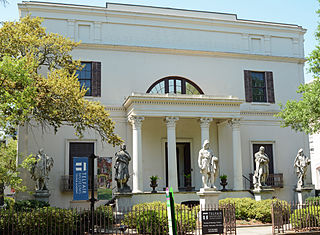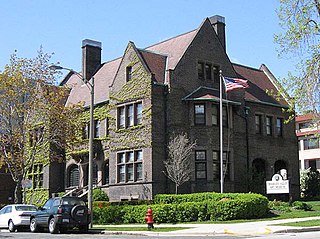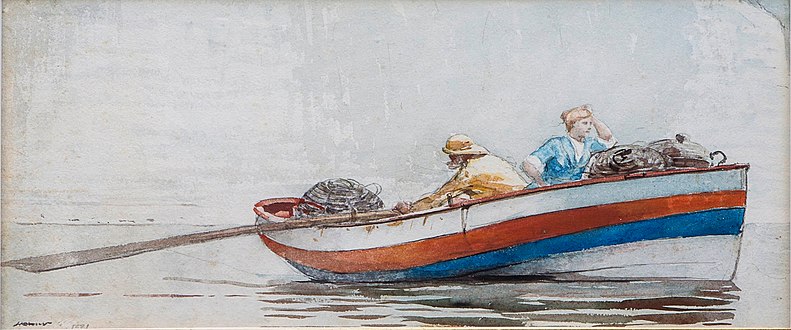
The Milwaukee Art Museum (MAM) is an art museum in Milwaukee, Wisconsin. Its collection contains nearly 25,000 works of art.

Carnegie Museums of Pittsburgh are four museums that are operated by the Carnegie Institute headquartered in the Carnegie Institute complex in the Oakland neighborhood of Pittsburgh, Pennsylvania. The Carnegie Institute complex, which includes the original museum, recital hall, and library, was added to the National Register of Historic Places on March 30, 1979.

The Paine Art Center and Gardens is a preserved historic estate with a mansion and gardens located in Oshkosh, Wisconsin. It includes public art galleries and botanic gardens on 3 acres (1.2 ha), and is listed on the National Register of Historic Places.

The Dr. Fisk Holbrook Day House, also known as Sunnyhill Home, is a historic house at 8000 West Milwaukee Avenue in Wauwatosa, Wisconsin. Built in 1874, it was the home of Doctor Fisk Holbrook Day (1826-1903), a prominent local physician and amateur geologist. The stylistically eclectic house was built in part to house Day's large collection of artifacts, and is the Milwaukee suburb's only major 19th-century mansion. It was declared a National Historic Landmark in 1997. It is privately owned and not open to the public.

The Racine Art Museum (RAM) and RAM's Charles A. Wustum Museum of Fine Arts are located in Racine, Wisconsin, U.S. The museum holds the largest and most significant contemporary craft collection in North America, with more than 9,500 objects from nationally and internationally recognized artists. The Racine Art Museum's mission is to exhibit, collect, preserve, and educate in the contemporary visual arts. Its goal is to elevate the stature of craft to fine arts by presenting contemporary crafts alongside paintings and sculptures.

The Cultural Center Historic District is a historic district located in Detroit, Michigan, which includes the Art Center : the Detroit Public Library, the Detroit Institute of Arts, and the Horace H. Rackham Education Memorial Building were listed on the National Register of Historic Places in 1983. The district contains several cultural attractions.
Alexander Chadbourne Eschweiler was an American architect with a practice in Milwaukee, Wisconsin. He designed both residences and commercial structures. His eye-catching Japonist pagoda design for filling stations for Wadham's Oil and Grease Company of Milwaukee were repeated over a hundred times, though only a very few survive. His substantial turn-of-the-20th-century residences for the Milwaukee business elite, in conservative Jacobethan or neo-Georgian idioms, have preserved their cachet in the city.

The Telfair Academy is a historic mansion at 121 Barnard Street in Savannah, Georgia. It was designed by William Jay and built in 1818, and is one of a small number of Jay's surviving works. It is one of three sites owned by Telfair Museums. Originally a family townhouse belonging to the Telfair family, it became a free art museum in 1886, and thus one of the first 10 art museums in America, and the oldest public art museum in the South. Its first director, elected in 1883, was artist Carl Ludwig Brandt, who spent winters in Savannah. It was declared a National Historic Landmark in 1976.

Richard Henry Park was an American sculptor who worked in marble and bronze. He was commissioned to do work by the wealthy of the nineteenth century. He did a marble bust of John Plankinton, an astute businessman who founded the meat industry in Wisconsin and was "Milwaukee's foremost citizen."

The Rahr–West Art Museum is an art museum in Manitowoc, Wisconsin. It is located in the Joseph Vilas Jr. House, which is listed on the National Register of Historic Places. The house is a significant example of Queen Anne style architecture in the United States.

Ruthmere, formerly the Albert and Elizabeth Beardsley Residence, is a three-story Beaux-Arts mansion that is the most prominent historic residence in Elkhart, Indiana, United States. Built in 1910, the Ruthmere Mansion is now open to the public as a museum, along with the neighboring Dr. Havilah Beardsley House.

Ferry & Clas was an architectural firm in Wisconsin. It designed many buildings that are listed on the National Register of Historic Places. George Bowman Ferry and Alfred Charles Clas were partners.

The Charles Allis House is a historic house located at 1630 East Royall Place in Milwaukee, Wisconsin. It is locally significant due to its association with Charles Allis, who took a deep interest in art and was the first president of the Milwaukee Art Society and a trustee of the Layton Art Gallery, among other things.

The Central Library is the headquarters for the Milwaukee Public Library System as well as for the Milwaukee County Federated Library System. Designated a Milwaukee Landmark in 1969, the building remains one of Milwaukee's most monumental public structures.

Elizabeth Ann or Anne Plankinton was an American philanthropist in the early 20th century, the daughter of Milwaukee businessman John Plankinton. She was also known as "Miss Lizzie" and the people of Milwaukee called Plankinton the "municipal patroness" because of her generosity. She made a large donation that built the first YWCA in Milwaukee. She also purchased an elaborate large-scale pipe organ for the newly constructed city auditorium.

Pedimental sculptures are sculptures within the frame of a pediment on the exterior of a building, some examples of which can be found in the United States. Pedimental sculpture pose special challenges to sculptors: the triangular composition limits the choices for figures or ornament at the ends, and the sculpture must be designed to be viewed both from below and from a distance.

The Elizabeth Plankinton House was a stone structure in Milwaukee, Wisconsin, USA, intended to be the residence for Elizabeth Plankinton. Built between 1886 and 1888 by John Plankinton for his daughter as a wedding gift, it cost at least $100,000. The architect Edward Townsend Mix designed the house in the Richardsonian Romanesque style. It was located opposite John Plankinton's own house on Grand Avenue in an upscale residential area of the western part of the city, near other mansions. Mrs. Margaret Johnston was the only person to have a permanent residence in the house (1896–1904). The Knights of Columbus used the property between 1910 and 1978. Despite being listed in the National Register of Historic Places in 1976, the house was demolished on October 11, 1980, to make way for student facilities for Marquette University. The facility ultimately built was the Marquette Alumni Memorial Union. It is extremely close to the site of the house, but the majority of the land occupied by the house remains a grass lawn in 2020.
Emily Parker Groom (1876–1975) was an American artist born in Wayland, Massachusetts. She remained an active painter until the age of 97, spending nearly her entire career in Wisconsin, and died in Milwaukee, Wisconsin.
Sam Himmelfarb was a Russian Empire-born, American artist and commercial exhibit designer, known for his modernist-influenced paintings of everyday people and urban scenes. He also designed the Frank Lloyd Wright-inspired Samuel and Eleanor Himmelfarb Home and Studio in Winfield, Illinois, which is listed on the National Register of Historic Places. Himmelfarb studied art at the Art Students League and National Academy of Design in New York and at the Wisconsin School of Fine and Applied Arts. He initially painted in a realist style influenced by the Ashcan School, which gave way to more modernist, increasingly abstract styles. His paintings appeared in exhibitions at the Art Institute of Chicago (AIC), Terra Museum of American Art, Milwaukee Art Institute, and Arts Club of Chicago, and in circulating shows from the American Federation of Arts, among other venues. He received awards from the AIC, Wisconsin State Fair and Milwaukee Art Museum, and his work belongs to the collection of the latter, and those of the Illinois State Museum, Block Museum, and Arkansas Art Center, among others. Himmelfarb was married to the artist and educator, Eleanor Himmelfarb (1910-2009); their son, John Himmelfarb, and grandchild, Serena Aurora Day Himmelfarb, are also artists.


















